Contents
- Diseases of apricot trees and their treatment (with photo)
- Parsha na apricot
- What is apricot cytosporosis, how to treat the disease
- Apricot leaf diseases and their treatment
- Apricot bark diseases
- Diseases of the roots of apricot
- Other apricot diseases and methods of their treatment
- Pests of apricot trees and their treatment (with photo)
- Protection of apricot from diseases and pests
- Conclusion
Apricot is one of the most popular and beloved stone fruits in our area, famous for its delicious fragrant fruits and a variety of varieties. In order for the tree to always serve as a decoration of the garden and give a generous harvest, it needs to be properly looked after. Be sure to know the most common apricot diseases and how to deal with them – including what measures to take to keep the trees healthy.
Diseases of apricot trees and their treatment (with photo)
In accordance with the causes of occurrence, all diseases of apricot trees are:
- infectious;
- non-infectious.
Infectious diseases arise as a result of the activity of pathogenic pathogens:
- fungi;
- viruses;
- bacteria.
Non-infectious may be the result of adverse environmental conditions (too high or low temperatures, lack or excess of water, malnutrition, high levels of harmful substances in the air or soil).
By the nature of the spread of apricot disease (with photos as examples), there are:
- local (affecting individual plant organs);

- common (spread throughout the body, which often leads to its death).

The whole variety of apricot diseases is also classified according to external manifestations (symptoms):
- raids (powdery coatings on the surface of leaves and other organs);
- discoloration of tissues (as an example – an apricot with red leaves, also appears on inflorescences, shoots);
- pustules (pads containing spores of pathogens, on the surface of various organs – “rust”);
- necrosis (death of tissues in the form of various spots – apricot leaves “into a hole” with clasterosporiosis, etc.);
- mummification (affected organs turn black and dry out);
- deformation (under the action of a pathogenic agent, leaves curl on the apricot, “pockets” of fruits appear);
- rot (destruction of previously softened tissues);
- wilting (cell turgor weakens sharply due to lack of water – it can also be viral, manifested in the fact that after flowering apricot leaves curl up);
- ulceration (indentations in softened tissues);
- tumors, growths (thickening of apricot branches, trunk, leaves as a result of a sharp increase in the number and volume of cells).
Parsha na apricot
One of the most “famous” fungal diseases affecting apricot trees is stone fruit scab.

Symptoms of the disease and causes of infection
Determining this disease of apricots is quite simple.
Primary (early) infection appears on the leaves:
- at first, these are greenish rounded marks with indistinct borders, randomly scattered on their reverse side;
- over time, the spots become brown, hard, can cover the entire vegetative organ, including the stalk and veins;
- with a strong defeat, the leaves of the apricot wither, dry and fall off;
- the same thing gradually begins to happen with the shoots.
Late manifestations of the disease affect the fruits:
- they become noticeable on unripe apricots as gray or brown hard spots;
- as the fetus matures, the area of the lesion grows;
- a velvety texture appears on the surface, changing color from olive to black;
- the fruit cracks, its pulp is destroyed, taste and attractive appearance are lost.
Causes of infection:
- stress – the reaction of the apricot to sudden changes in the weather, which weakens the tree and makes it vulnerable to infections;
- the causative agent of the disease is activated at high humidity, during sharp temperature fluctuations (in spring);
- preventive measures not taken in a timely manner or carried out incorrectly.
What is the causative agent of scab
The causative agent of the disease is a pathogenic fungus that hibernates in the form of small dark balls on fallen leaves. In the spring, its spores are released and dispersed during rainy, wet weather, infecting healthy stone fruit trees.
How to spray apricot from scab
As control measures, apricot from scab should be treated with fungicides of new generations – Kaptan-50 (0,3%) or Topsin-M (0,1%).
Spray schedule:
- the first time – before flowering;
- after flowering is completed – repeat;
- further – every 10-14 days, if necessary, from 3 to 6 times.
The fight against scab folk methods
You can try to treat scab on apricot and with the help of folk remedies:
- irrigate the trunk, crown of the tree, as well as the near-stem circle with a solution of mustard powder (40 g per 5 l of water);
- in spring, summer, early autumn, spray with a solution of potassium permanganate in a rich pink color.
A set of preventive measures
If the processing of apricot from scab is carried out when the signs of the disease have already manifested themselves, then preventive measures are designed to prevent infection of the trees.
For these purposes it is necessary:
- gently water the apricots without over-moistening the soil;
- carry out annual pruning of branches, removing dry and damaged ones;
- in summer, carefully weed out weeds, in autumn – collect and burn fallen leaves;
- regularly loosen the soil in the trunk circle;
- inspect the shoots, leaves and fruits of trees for the presence of a fungus;
- in the spring, carry out preventive spraying of apricots with Bordeaux liquid (1%), lime-sulphur solution, and fumigation with sawdust.

What is apricot cytosporosis, how to treat the disease
Very often in the mouths of gardeners you can hear a complaint: “the apricot dries up, leaves, twigs withered.” This is a characteristic sign of another serious disease – cytosporous desiccation. The spores of its pathogen (fungus) infect wood in places of damage, on cuts, cuts.
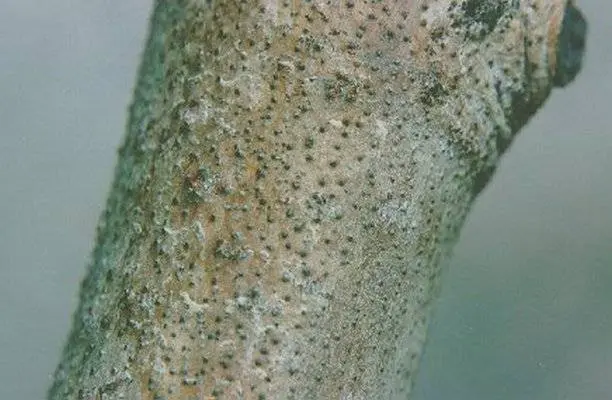
Signs of the disease:
- as a rule, at the beginning of summer, after flowering, the young branches and tops of the shoots wither sharply and dry at the apricot;
- characteristic smudges of brown color form on them;
- the bark acquires a brown hue, many wounds appear on it, flowing with gum;
- Gradually, the apricot wood is covered with black tubercles, which next year will turn into rough growths of a fungus that has grown deep into the depths.
You can save a tree only at the initial stage of the disease, so you need to act as soon as possible:
- all affected branches should be removed, capturing 10 cm from their healthy part;
- in the spring, be sure to cut the apricot;
- the wound surface must be covered with garden pitch, deep hollows must be cemented;
- in the fall, add top dressing (phosphorus, potassium) to the soil, do not forget about systematic watering.
Apricot leaf diseases and their treatment
A gardener will need a brief description of the diseases of apricot trees (with a photo for visual representation), the manifestations of which are clearly visible on the leaves.
Gray rot (moniliosis) – spread by insects and wind, mainly in cloudy weather:
- apricot dries after flowering, young shoots wither, turn brown;
- the fruits are covered with dark spots, rot;
- apricot leaves curl, dry out, acquiring resemblance to burnt ones.

Disease control measures:
- timely destruction of affected leaves, shoots, fruits;
- spraying with Bordeaux liquid (3%) at the stage of bud swelling;
- processing the crown of a diseased apricot with a solution of Topsin-M, Strobi, Topaz with the addition of laundry soap shavings.
Gnomoniosis, or brown spotting, is a disease that affects the crown and fruits:
- first manifested by yellow marks on the leaf blades;
- the leaves on the apricot turn red, turn brown, then dry;
- fruits fall off before ripening, or become twisted, ugly.
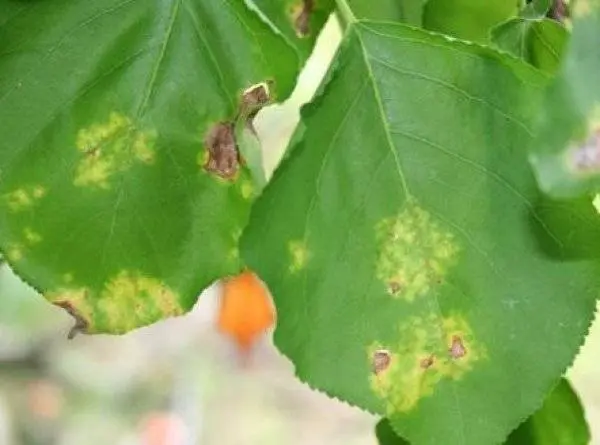
Disease control measures:
- thorough cleaning of the affected areas of the tree;
- soil treatment under apricot with a solution of copper sulfate (1%);
- in early spring, spraying the crown with Bordeaux liquid.
Apricot leaf curl (pictured) is one of the most dangerous fungal diseases, the result of which can be a complete loss of the crop:
- leaf plates are covered with yellow blisters, which gradually change color to dark red;
- their shape is bent, swelling (“curlyness”) of a reddish color appears;
- after the mass death of the leaves, the death of the apricot fruits, the deformation of the shoots begins.
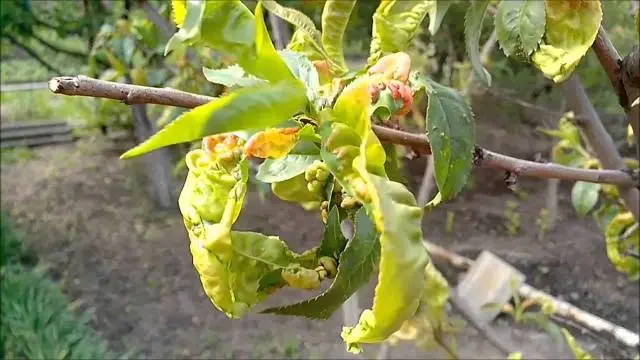
Disease control measures:
- removal of all damaged organs;
- treatment of apricot with pesticides containing copper;
- application of organic fertilizers in the spring to the soil.
Verticillosis (wilt) is an apricot disease caused by a fungus that lives in the soil:
- apricot leaves turn yellow, curl, fall off en masse, starting from the bottom of the tree;
- this is followed by the death of the shoots, slowly capturing the entire plant to the very top.
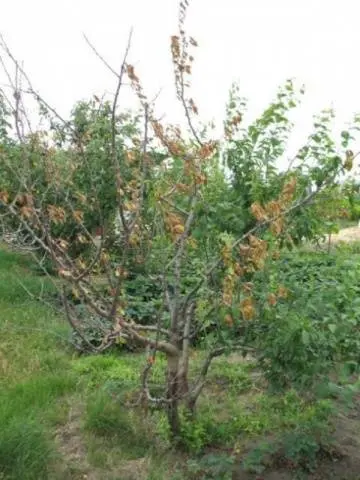
Treatment measures:
- spraying with a solution of Fundazol, Vitaros, Previkur (0,2%);
- timely prevention of apricot disease (avoiding damage to the roots, buying quality seedlings, antifungal tillage).
Viral wilt often affects stone fruit after grafting or budding:
- apricot leaves wither, blossoming simultaneously with flowers;
- the plates become thicker, curl, become stained;
- then the fruits are affected – the pulp dies, starting from the stone.
This apricot disease is easier to prevent than to treat:
- when grafting and pruning, use a tool treated with disinfectant solutions or heated;
- for prevention, treat the trunk with lime and copper sulfate;
- prevent damage by pests, properly fertilize.
Klyasterosporiosis, or perforated spotting, most often affects trees in spring and autumn:
- holes appear on apricot leaves, which are preceded by brown spots;
- shoots are covered with dark marks, from which gum flows.
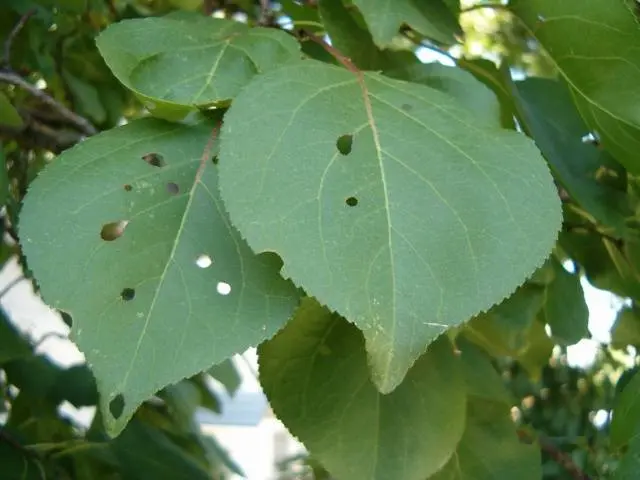
Disease treatment measures:
- pruning and destruction of the affected parts of the tree;
- spraying in spring and autumn with Bordeaux mixture (4%) or copper sulfate (1%);
- Chorus is effective in the rosebud phase and is safe for bees.
Apricot bark diseases
It is worth dwelling in more detail on the description of apricot diseases with photographs of their manifestations on the bark of a tree.
Mushroom Vals looks like knotty growths (ulcers) of bright orange color on the trunk and branches. Getting inside through wounds and cracks, it affects the tissues of the wood and prevents the normal circulation of the juice.
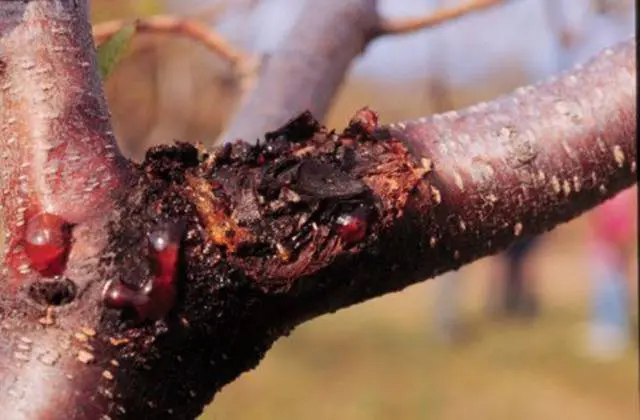
Disease control measures:
- do not overmoisten the soil;
- pruning regularly;
- use fungicides in case of damage.
Gum flow – sticky amber “tears”, appearing in abundance in the cracks of the branches and trunk. This is a sign that the tree is sick or forced to grow in adverse conditions.

Cortical damage can also be caused by:
- frostbite;
- sunburn;
- mosses and lichens parasitizing on it;
- accidental mechanical damage when caring for a tree;
- activity of pests and rodents.
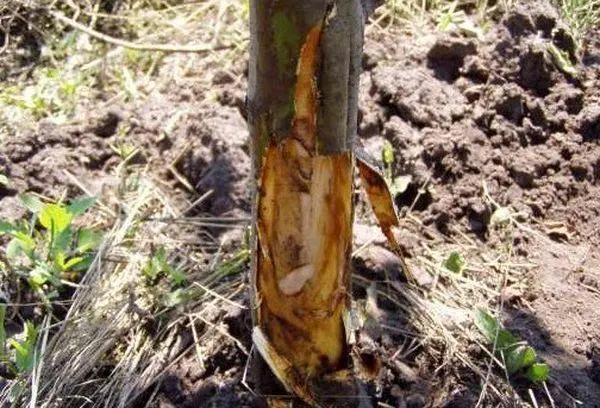
Recommend:
- gently peel the bark to living wood;
- allow the surface of the wound to dry slightly;
- disinfect it with an antifungal drug;
- treat with healing putty – garden pitch.
Instead of a garden pitch, a mixture of clay and mullein is often used, diluted with a solution of Bordeaux liquid, copper sulphate, or another copper-containing preparation.
Diseases of the roots of apricot
Determining an apricot disease by leaves or bark is much easier than by roots. However, this part of the plant is also very vulnerable, requiring careful attention and proper care.
Spores of many fungi are found in the soil. They infect the tree, penetrating inside through cracks and damage, including on the roots. To avoid this, you should:
- when choosing a seedling for planting, pay attention to ensure that its root system is healthy and developed;
- very carefully carry out garden work inside the near-trunk circle: fertilizing, loosening the soil, mulching;
- do not plant nightshade crops (tomato, eggplant, pepper) next to the apricot tree, which can serve as a source of infection that is transmitted through the roots.
Often young shoots appear around the apricot – root offspring. As a rule, this is also evidence of the unfavorable state of the roots: damage to them by frost, rodents, or mechanical injury. Although there are varieties for which the presence of offspring is simply their feature.
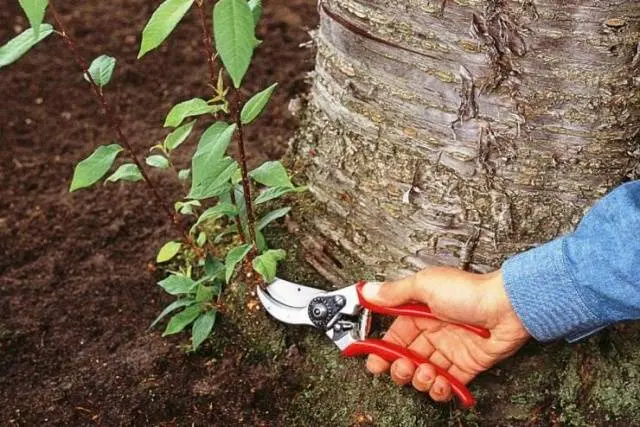
Other apricot diseases and methods of their treatment
Here are a few more apricot diseases and their treatments that you should know.
A bacterial burn is a severe and difficult-to-treat disease of fruit trees that can destroy an entire orchard:
- flowers are the first to suffer – they turn brown, wither and fall off;
- after flowering, branches and young shoots dry on the apricot;
- leaves and buds turn black;
- cracks are observed on the bark, from which a milky-white liquid oozes.
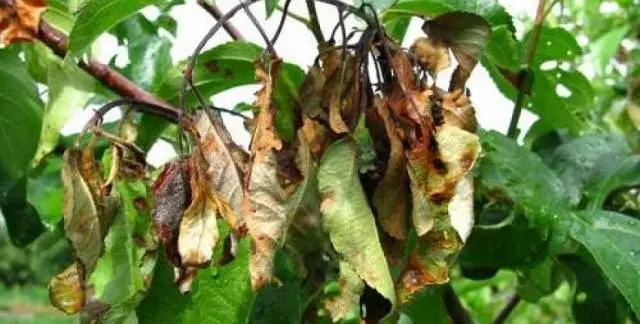
Control measures:
- spraying a diseased tree from May to June with Azofos solution (5%) and antibiotics (streptomycin, kanamycin);
- treatment during the flowering period with preparations containing copper;
- uprooting wild crops and hawthorn (potential carriers of the disease) within a radius of 100 m around the orchard.
Apoplexy is another dangerous disease caused by a metabolic disorder due to sudden changes in environmental conditions (in particular, temperature changes):
- as a rule, at the beginning of summer, the leaves begin to wither sharply (for no apparent external reasons);
- branches dry up;
- the wood on the trunk dries up.
The tree will quickly die if measures are not taken in time:
- cut off the affected branches, disinfecting and treating all cut points with garden pitch;
- to prevent the disease at the end of October, the trunk and branches of the apricot must be whitened;
- for the winter, be sure to cover the tree, especially the young.
Often gardeners complain that the color of the apricot falls off. This phenomenon should be carefully studied, as there may be several reasons:
- this is how moniliosis, which was discussed above, manifests itself;
- if the apricot variety is not self-fertile, perhaps the fact is that there is no pollinator tree nearby, or it does not bloom;
- there is a possibility that the matter is in bad weather (cold or strong wind), as a result of which the bees and other insects are not active enough.

Prevention of apricot diseases
General preventive measures will help minimize the risks associated with diseases of apricots and other fruit trees on the site. Do not neglect these, at first glance, simple actions that can actually make life easier for the gardener:
- use only healthy seedlings when planting;
- timely and correctly feed the trees with fertilizers;
- fight weeds and pests;
- before pruning and grafting, be sure to disinfect the instrument and hands;
- treat the cut sites with special disinfecting solutions;
- observe the condition of the trunk, branches, leaves throughout the season;
- remove and burn fallen leaves in a timely manner;
- in the fall, be sure to do moisture charging.
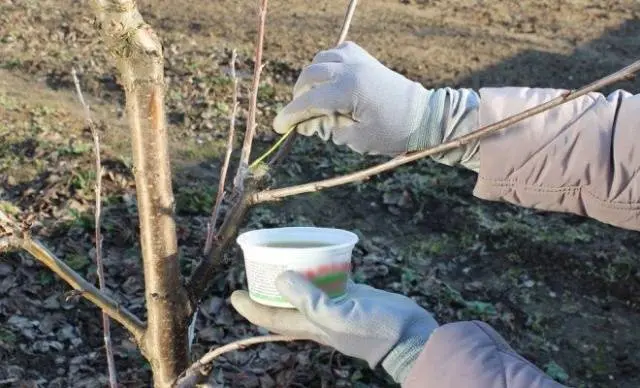
Useful tips for the treatment and prevention of apricot diseases are given in the video
Pests of apricot trees and their treatment (with photo)
Now we should briefly dwell on the most common apricot pests and their control (photos will help to imagine what kind of insects we are talking about).
The leaf roller is a small gray-brown moth. Its caterpillars eat leaves and buds in spring. It is often possible to observe how the leaves of an apricot curl up. The caterpillar lives in these “tubes”. Such leaves need to be cut off and destroyed.
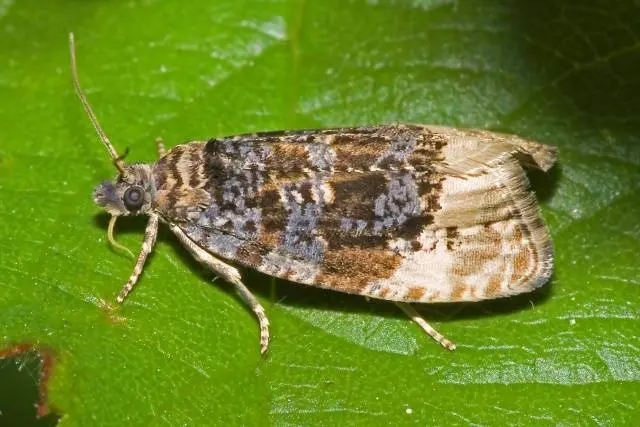
Aphids are colonies of small black, green or brown insects that feed on the cell sap of the plant’s vegetative organs. They settle on the underside of the leaves, young shoots, which first curl and become sticky, and eventually turn yellow and dry out. Where aphids appeared, an anthill is necessarily located nearby.
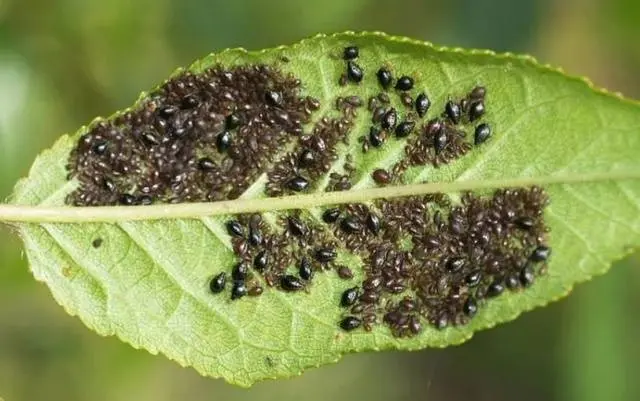
The codling moth is a small dark butterfly. Her caterpillars are a real scourge of the orchard. Hatching in late summer and early autumn, they massively infect the fruits.
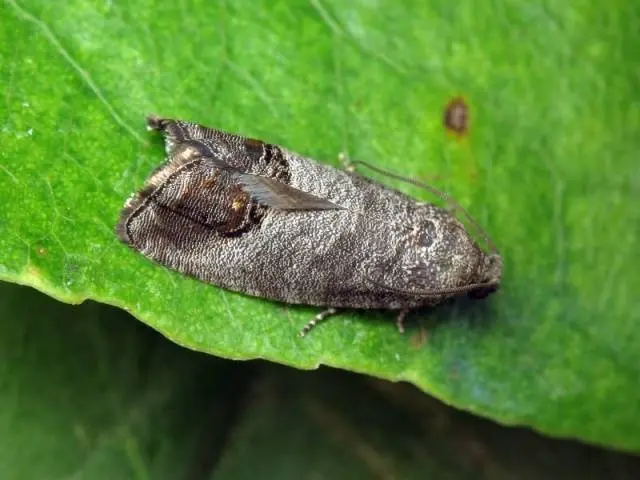
Weevils are small blue or green beetles that overwinter in damaged bark and topsoil. Leaves, buds, flowers, fruits are damaged. With a strong defeat, the apricot blooms poorly, already at the beginning of summer sheds a significant part of the foliage.
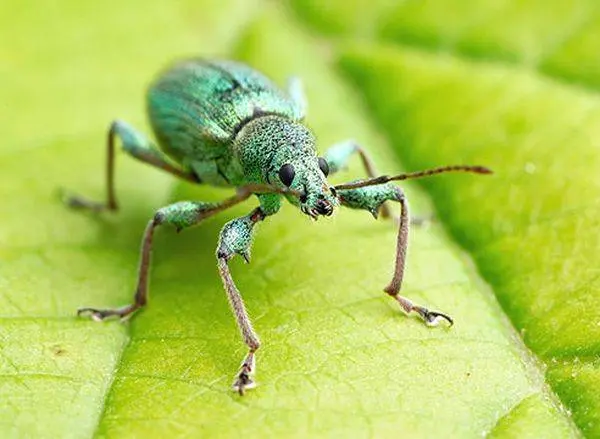
The fruit striped moth is a gray moth with thin black stripes on the body and wings. Its caterpillars cause severe damage to the shoots and buds of stone fruit trees, biting into them and thereby provoking death.
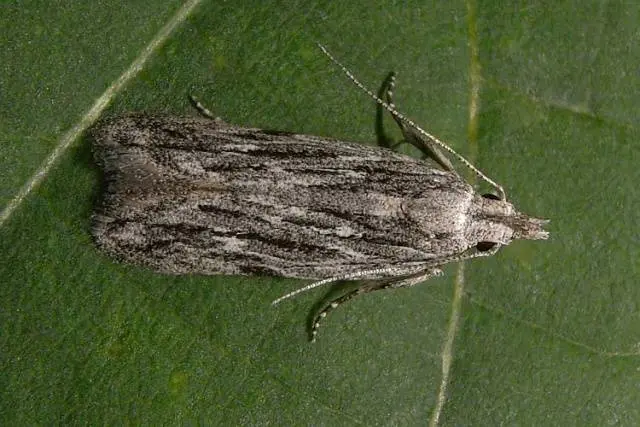
How to deal with pests on apricot
General recommendations for pest control of apricot trees are as follows:
- cut and burn damaged shoots in a timely manner, collect and destroy affected leaves and fruits;
- whitewash tree trunks;
- loosen the soil in the near-trunk circle, destroying insects wintering there;
- treat trees with insecticidal preparations suitable for controlling specific apricot pests.
Protection of apricot from diseases and pests
Information about diseases, apricot pests and methods of dealing with them should be supplemented with tree protection measures to prevent trouble.
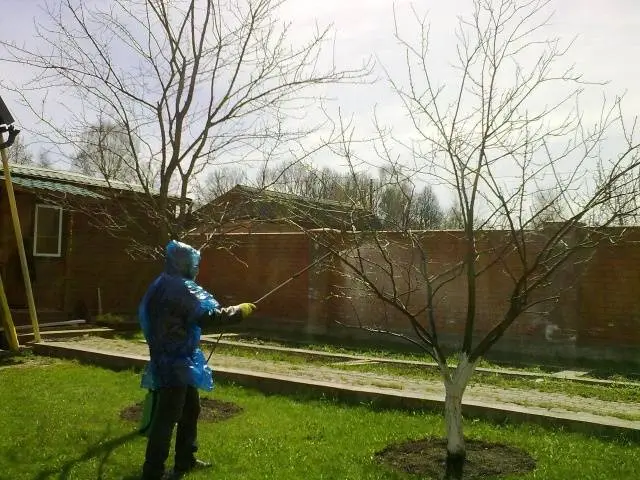
Processing apricot in the spring from pests and diseases
Spring processing of apricot from diseases and pests includes:
- sanitary pruning of the tree, thinning of branches before the buds swell;
- removal (using a special metal brush) of larvae, caterpillars, egg clutches, green lichen;
- before the buds open, spraying the tree with Bordeaux mixture (3%);
- 2 weeks after flowering (and then according to the instructions of the preparation used), crown treatment with Bordeaux liquid 1%, copper oxychloride, Cineb or Kaptan.
Processing fruit crops in summer and autumn
Prevention of diseases and pests of apricot should also be carried out in the summer and autumn periods.
In summer (but no later than 2 weeks before the start of harvesting), trees can be treated with Horus, colloidal sulfur, antifungal drugs.
Autumn prevention involves the following:
- after the leaves fall, it is advised to treat the trees with a solution of urea (700 g per 10 liters of water);
- in late autumn, spraying with preparations containing copper is indicated;
- if you did not have time to do the treatment before the onset of cold weather, use iron sulfate.
Conclusion
Apricot diseases and the fight against them are the inevitable realities that every gardener faces when growing these trees in his area. Timely and correctly recognized symptoms of a disease or harmful activity of insects will help determine the necessary course of action and select drugs to save the tree with the least possible damage to its health. We should not forget about proper and regular prevention – it is always easier to prevent an ailment than to treat it later.











